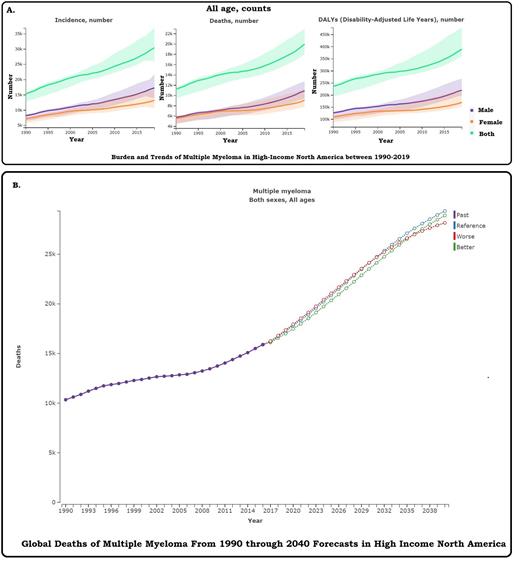Background: Multiple myeloma (MM), a malignant neoplasm originating from plasma cells, imposes a considerable health burden in high-income North America (HINA). It ranks as the 14th leading cause of cancer-related deaths and disability in HINA countries. This study aims to assess the epidemiological aspects of MM, including its incidence, prevalence, mortality rates, and non-fatal health outcomes across HINA countries over the last three decades (1990-2019) with projections of deaths up to 2040.
Methods: Using the Global Burden of Disease methodology, we evaluated MM prevalence, incidence, mortality, and disability-adjusted life years (DALYs) based on age group, sex, and year across HINA from 1990 to 2019, utilizing standardized approaches and statistical modeling. We employed a regression framework to forecast MM deaths through 2040, and the results were presented in absolute counts and age-standardized rates (per 100,000 person-years).
Results: The absolute prevalence of MM increased from 42,637 (95% uncertainty interval (UI): 35,449-44,970) in 1990 to 101,994 (95% UI: 86,889-127,309) in 2019. Similarly, deaths increased from 11,200 (95% UI: 9,435-11,633) to 19,941 (95% UI: 18,012-22,919) during 1990-2019, and DALYs increased from 235,334 (95% UI: 194,820-244,361) in 1990 to 388,955 (95% UI: 360,494-478,317) in 2019. The age-standardized incidence rate (ASIR) increased from 4.32 (95% UI: 3.62-4.5) to 4.8 (95% UI: 4.12-5.87) cases per 100,000 persons from 1990-2019. However, the annual percentage of change (APC) in age-standardized mortality rate (ASMR) and age-standardized DALY rate (ASDALR) decreased by 1% and 8%, respectively, from 1990-2019. Among HINA countries, Canada observed the highest APC increase in total deaths (111%), followed by Greenland (110%) and the United States (75%) during 1990-2019. In terms of age groups, the 70-74 age group observed the highest number of incidences (5,257), deaths (3,336), and DALYs (67,310) in 2019. The 80+ age group exhibited the highest APC in total deaths, incidence, and DALYs from 1990-2019. Furthermore, males experienced a higher burden compared to females over the last three decades. The projected number of MM deaths in HINA is expected to reach 28,904 (95% UI: 22,690-37,300) by 2040.
Conclusion: This study reveals the secular trend of MM burden in HINA, indicating a significant increase in MM cases and its impact on public health. MM accounted for 2.295% of deaths among all cancer-related deaths in HINA in 2019. The burden of MM has been on the rise in general from 1990 to 2019 and is predicted to continue increasing over the next two decades. Notably, there is a noticeable disparity in MM burden, with higher prevalence in males compared to females. Age and cohort effects appear to play a significant role, with elevated risk observed among elderly individuals and those from earlier-born cohorts. Nonetheless, continuous surveillance, data collection, and research efforts are crucial to monitor evolving epidemiological trends and inform evidence-based policies aimed at mitigating the impact of multiple myeloma on individuals and society in the region.
Disclosures
No relevant conflicts of interest to declare.


This feature is available to Subscribers Only
Sign In or Create an Account Close Modal